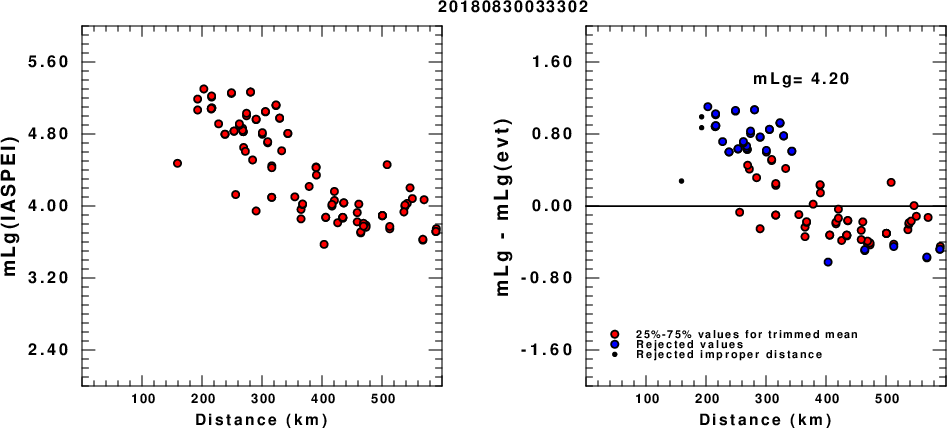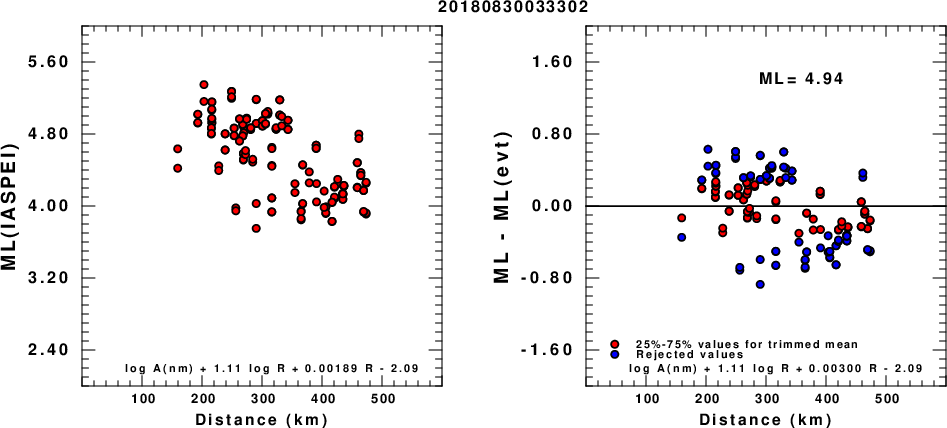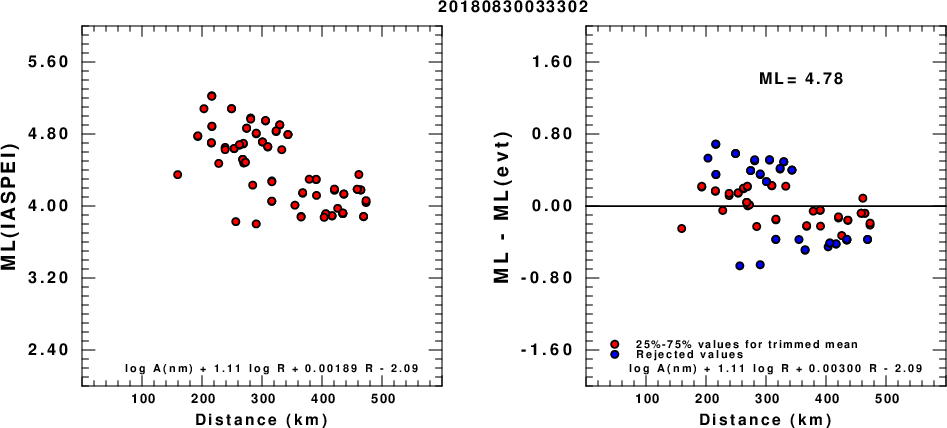
(a) mLg computed using the IASPEI formula; (b) mLg residuals ; the values used for the trimmed mean are indicated.
USGS/SLU Moment Tensor Solution
ENS 2018/08/30 03:33:02:8 44.05 16.58 10.0 4.6 Bosnia Herzogovina
Stations used:
CR.STON CR.ZAG GE.PSZ HT.FNA HU.BEHE HU.BSZH HU.BUD HU.CSKK
HU.KOVH HU.MORH HU.MPLH HU.PSZ HU.SOP HU.TIH ME.KOME
OE.ARSA OE.BIOA OE.CONA OE.CSNA OE.KBA OE.MOA OE.MYKA
OE.OBKA OE.RONA OE.SOKA RO.BZS RO.HERR RO.MDVR RO.SIRR
SJ.BBLS SJ.FRGS SL.BOJS SL.CADS SL.CEY SL.CRES SL.CRNS
SL.DOBS SL.GBAS SL.GBRS SL.GCIS SL.GORS SL.GROS SL.KOGS
SL.LJU SL.MOZS SL.PERS SL.ROBS SL.SKDS SL.VISS SL.VOJS
Filtering commands used:
cut o DIST/3.3 -30 o DIST/3.3 +70
rtr
taper w 0.1
hp c 0.02 n 3
lp c 0.06 n 3
Best Fitting Double Couple
Mo = 7.08e+22 dyne-cm
Mw = 4.50
Z = 16 km
Plane Strike Dip Rake
NP1 146 76 164
NP2 240 75 15
Principal Axes:
Axis Value Plunge Azimuth
T 7.08e+22 21 103
N 0.00e+00 69 284
P -7.08e+22 0 193
Moment Tensor: (dyne-cm)
Component Value
Mxx -6.41e+22
Mxy -2.91e+22
Mxz -4.89e+21
Myy 5.49e+22
Myz 2.33e+22
Mzz 9.16e+21
--------------
----------------------
###-------------------------
####--------------------------
#######---------------------------
########--------------------------##
##########------------------##########
############------------################
#############-------####################
###############---########################
###############-##########################
#############----################### ###
##########--------################## T ###
#######------------################ ##
#####---------------####################
##-------------------#################
---------------------###############
----------------------############
----------------------########
-----------------------#####
----- --------------
- P ----------
Global CMT Convention Moment Tensor:
R T P
9.16e+21 -4.89e+21 -2.33e+22
-4.89e+21 -6.41e+22 2.91e+22
-2.33e+22 2.91e+22 5.49e+22
Details of the solution is found at
http://www.eas.slu.edu/eqc/eqc_mt/MECH.NA/20180830033302/index.html
|
STK = 240
DIP = 75
RAKE = 15
MW = 4.50
HS = 16.0
The NDK file is 20180830033302.ndk The waveform inversion is preferred.
The following compares this source inversion to others
USGS/SLU Moment Tensor Solution
ENS 2018/08/30 03:33:02:8 44.05 16.58 10.0 4.6 Bosnia Herzogovina
Stations used:
CR.STON CR.ZAG GE.PSZ HT.FNA HU.BEHE HU.BSZH HU.BUD HU.CSKK
HU.KOVH HU.MORH HU.MPLH HU.PSZ HU.SOP HU.TIH ME.KOME
OE.ARSA OE.BIOA OE.CONA OE.CSNA OE.KBA OE.MOA OE.MYKA
OE.OBKA OE.RONA OE.SOKA RO.BZS RO.HERR RO.MDVR RO.SIRR
SJ.BBLS SJ.FRGS SL.BOJS SL.CADS SL.CEY SL.CRES SL.CRNS
SL.DOBS SL.GBAS SL.GBRS SL.GCIS SL.GORS SL.GROS SL.KOGS
SL.LJU SL.MOZS SL.PERS SL.ROBS SL.SKDS SL.VISS SL.VOJS
Filtering commands used:
cut o DIST/3.3 -30 o DIST/3.3 +70
rtr
taper w 0.1
hp c 0.02 n 3
lp c 0.06 n 3
Best Fitting Double Couple
Mo = 7.08e+22 dyne-cm
Mw = 4.50
Z = 16 km
Plane Strike Dip Rake
NP1 146 76 164
NP2 240 75 15
Principal Axes:
Axis Value Plunge Azimuth
T 7.08e+22 21 103
N 0.00e+00 69 284
P -7.08e+22 0 193
Moment Tensor: (dyne-cm)
Component Value
Mxx -6.41e+22
Mxy -2.91e+22
Mxz -4.89e+21
Myy 5.49e+22
Myz 2.33e+22
Mzz 9.16e+21
--------------
----------------------
###-------------------------
####--------------------------
#######---------------------------
########--------------------------##
##########------------------##########
############------------################
#############-------####################
###############---########################
###############-##########################
#############----################### ###
##########--------################## T ###
#######------------################ ##
#####---------------####################
##-------------------#################
---------------------###############
----------------------############
----------------------########
-----------------------#####
----- --------------
- P ----------
Global CMT Convention Moment Tensor:
R T P
9.16e+21 -4.89e+21 -2.33e+22
-4.89e+21 -6.41e+22 2.91e+22
-2.33e+22 2.91e+22 5.49e+22
Details of the solution is found at
http://www.eas.slu.edu/eqc/eqc_mt/MECH.NA/20180830033302/index.html
|

(a) mLg computed using the IASPEI formula; (b) mLg residuals ; the values used for the trimmed mean are indicated.

(a) ML computed using the IASPEI formula for Horizontal components; (b) ML residuals computed using a modified IASPEI formula that accounts for path specific attenuation; the values used for the trimmed mean are indicated. The ML relation used for each figure is given at the bottom of each plot.

(a) ML computed using the IASPEI formula for Vertical components (research); (b) ML residuals computed using a modified IASPEI formula that accounts for path specific attenuation; the values used for the trimmed mean are indicated. The ML relation used for each figure is given at the bottom of each plot.
 |
The focal mechanism was determined using broadband seismic waveforms. The location of the event and the and stations used for the waveform inversion are shown in the next figure.

|
|
|
The program wvfgrd96 was used with good traces observed at short distance to determine the focal mechanism, depth and seismic moment. This technique requires a high quality signal and well determined velocity model for the Green functions. To the extent that these are the quality data, this type of mechanism should be preferred over the radiation pattern technique which requires the separate step of defining the pressure and tension quadrants and the correct strike.
The observed and predicted traces are filtered using the following gsac commands:
cut o DIST/3.3 -30 o DIST/3.3 +70 rtr taper w 0.1 hp c 0.02 n 3 lp c 0.06 n 3The results of this grid search from 0.5 to 19 km depth are as follow:
DEPTH STK DIP RAKE MW FIT
WVFGRD96 1.0 240 75 -15 4.15 0.2635
WVFGRD96 2.0 235 70 -25 4.26 0.3239
WVFGRD96 3.0 235 65 -30 4.30 0.3495
WVFGRD96 4.0 240 75 -20 4.30 0.3686
WVFGRD96 5.0 240 80 -20 4.32 0.3870
WVFGRD96 6.0 240 80 -20 4.34 0.4043
WVFGRD96 7.0 245 75 20 4.37 0.4215
WVFGRD96 8.0 245 75 25 4.40 0.4389
WVFGRD96 9.0 245 70 25 4.42 0.4527
WVFGRD96 10.0 240 80 20 4.43 0.4636
WVFGRD96 11.0 240 75 20 4.44 0.4730
WVFGRD96 12.0 240 75 20 4.46 0.4810
WVFGRD96 13.0 240 75 20 4.47 0.4864
WVFGRD96 14.0 240 75 20 4.48 0.4897
WVFGRD96 15.0 240 75 15 4.49 0.4915
WVFGRD96 16.0 240 75 15 4.50 0.4924
WVFGRD96 17.0 240 75 15 4.51 0.4918
WVFGRD96 18.0 240 75 15 4.52 0.4899
WVFGRD96 19.0 240 75 15 4.53 0.4869
WVFGRD96 20.0 240 80 15 4.53 0.4830
WVFGRD96 21.0 240 80 15 4.54 0.4783
WVFGRD96 22.0 240 80 15 4.55 0.4728
WVFGRD96 23.0 240 80 15 4.56 0.4664
WVFGRD96 24.0 240 80 15 4.57 0.4595
WVFGRD96 25.0 240 80 15 4.57 0.4519
WVFGRD96 26.0 240 80 15 4.58 0.4438
WVFGRD96 27.0 240 80 10 4.59 0.4353
WVFGRD96 28.0 240 80 10 4.60 0.4267
WVFGRD96 29.0 240 80 10 4.61 0.4176
The best solution is
WVFGRD96 16.0 240 75 15 4.50 0.4924
The mechanism correspond to the best fit is

|
|
|
The best fit as a function of depth is given in the following figure:

|
|
|
The comparison of the observed and predicted waveforms is given in the next figure. The red traces are the observed and the blue are the predicted. Each observed-predicted component is plotted to the same scale and peak amplitudes are indicated by the numbers to the left of each trace. A pair of numbers is given in black at the right of each predicted traces. The upper number it the time shift required for maximum correlation between the observed and predicted traces. This time shift is required because the synthetics are not computed at exactly the same distance as the observed and because the velocity model used in the predictions may not be perfect. A positive time shift indicates that the prediction is too fast and should be delayed to match the observed trace (shift to the right in this figure). A negative value indicates that the prediction is too slow. The lower number gives the percentage of variance reduction to characterize the individual goodness of fit (100% indicates a perfect fit).
The bandpass filter used in the processing and for the display was
cut o DIST/3.3 -30 o DIST/3.3 +70 rtr taper w 0.1 hp c 0.02 n 3 lp c 0.06 n 3

|
|
|

|
| Focal mechanism sensitivity at the preferred depth. The red color indicates a very good fit to thewavefroms. Each solution is plotted as a vector at a given value of strike and dip with the angle of the vector representing the rake angle, measured, with respect to the upward vertical (N) in the figure. |
A check on the assumed source location is possible by looking at the time shifts between the observed and predicted traces. The time shifts for waveform matching arise for several reasons:
Time_shift = A + B cos Azimuth + C Sin Azimuth
The time shifts for this inversion lead to the next figure:

The derived shift in origin time and epicentral coordinates are given at the bottom of the figure.
Thanks also to the many seismic network operators whose dedication make this effort possible: University of Nevada Reno, University of Alaska, University of Washington, Oregon State University, University of Utah, Montana Bureas of Mines, UC Berkely, Caltech, UC San Diego, Saint Louis University, University of Memphis, Lamont Doherty Earth Observatory, the Iris stations and the Transportable Array of EarthScope.
The WUS.model used for the waveform synthetic seismograms and for the surface wave eigenfunctions and dispersion is as follows:
MODEL.01
Model after 8 iterations
ISOTROPIC
KGS
FLAT EARTH
1-D
CONSTANT VELOCITY
LINE08
LINE09
LINE10
LINE11
H(KM) VP(KM/S) VS(KM/S) RHO(GM/CC) QP QS ETAP ETAS FREFP FREFS
1.9000 3.4065 2.0089 2.2150 0.302E-02 0.679E-02 0.00 0.00 1.00 1.00
6.1000 5.5445 3.2953 2.6089 0.349E-02 0.784E-02 0.00 0.00 1.00 1.00
13.0000 6.2708 3.7396 2.7812 0.212E-02 0.476E-02 0.00 0.00 1.00 1.00
19.0000 6.4075 3.7680 2.8223 0.111E-02 0.249E-02 0.00 0.00 1.00 1.00
0.0000 7.9000 4.6200 3.2760 0.164E-10 0.370E-10 0.00 0.00 1.00 1.00
Here we tabulate the reasons for not using certain digital data sets
The following stations did not have a valid response files: